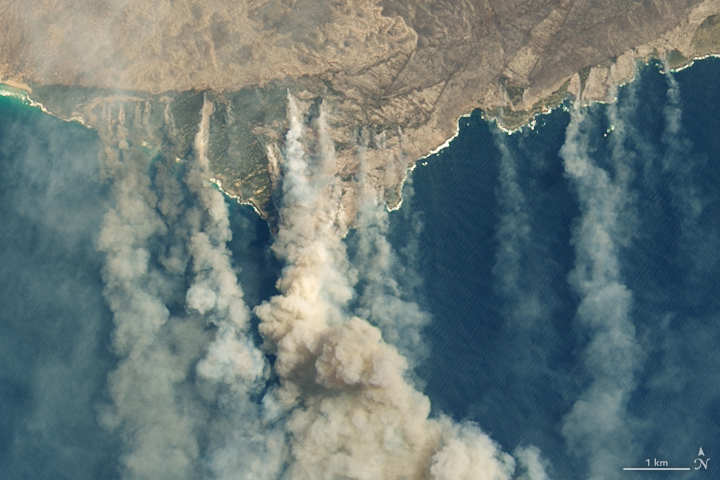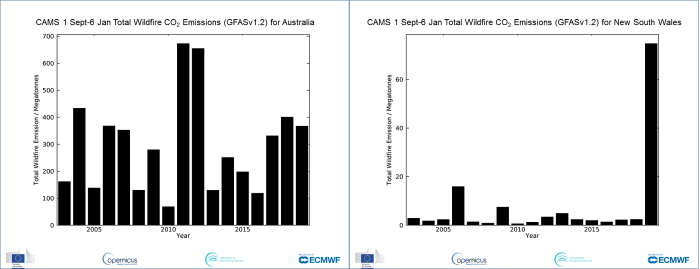Australia’s fires have pumped out more emissions than 100 nations combined

The wildfires raging along Australia’s eastern coast have already pumped around 400 million metric tons of carbon dioxide into the atmosphere, further fueling the climate change that’s already intensifying the nation’s fires.
That’s more than the total combined annual emissions of the 116 lowest-emitting countries, and nine times the amount produced during California’s record-setting 2018 fire season. It also adds up to about three-quarters of Australia’s otherwise flattening greenhouse-gas emissions in 2019.
And yet, 400 million tons isn’t an unprecedented amount nationwide at this point of the year in Australia, where summer bush fires are common, the fire season has been growing longer, and the number of days of “very high fire danger” is increasing.
Wildfires emissions topped 600 million tons from September through early January during the brutal fire seasons of 2011 and 2012, according to the European Union’s Copernicus Atmosphere Monitoring Service.

But emissions are way beyond typical levels in New South Wales, where this year’s fires are concentrated. More than 5.2 million hectares (12.8 million acres) have burned across the southeastern state since July 1, according to a statement from the NSW Rural Fire Service.
Climate change doesn’t spark wildfires. But rising temperatures and decreasing rainfall dries out trees, plants, and soil, converting them into fuel that can amplify fires when they do break out.
A 2018 report by Australia’s national science agency and the Bureau of Meteorology concludes climate change has contributed to the nation’s worsening fire conditions, noting that average temperatures have risen more than 1 ˚C.
In turn, these huge fires are fueling climate change. As trees and plants burn, they release the carbon stored in their trunks, leaves, branches, and roots. That creates a vicious feedback loop, as the very impacts of climate change further exacerbate it, complicating our ability to get ahead of the problem.
The fires have had devastating effects on the ground in Australia:
- Reports put the total area burned in recent weeks at more than 10 million hectares (25 million acres). That’s well ahead of the devastating Amazon fires last year, which covered more than 17 million acres. And it’s nearly 13 times the area burned during California’s 2018 fire season, which was the deadliest and most destructive in state history.
- More than 25 people have died, and officials have urged hundreds of thousands to evacuate. Tens of thousands more are protesting the government’s handling of the disaster.
- Thousands of homes have been destroyed, and smoke has blanketed more than 20 million square kilometers (7.7 million square miles).
- One University of Sydney professor estimates that more than one billion animals have been killed in the fires, based on earlier estimates of mammal, bird, and reptile populations in affected regions.
“It’s probably fairly well known that Australia’s got the world's highest rate of extinction for mammals,” Chris Dickman, a professor of terrestrial ecology, said in an interview with National Public Radio. “It’s events like this that may well hasten the extinction process for a range of other species. So it's a very sad time.”
The situation grew more dangerous in recent days, as hot and windy conditions returned. Two giant fires merged into a “megafire” straddling New South Wales and Victoria, and covering some 600,000 hectares (1.5 million acres).
Deep Dive
Climate change and energy
The problem with plug-in hybrids? Their drivers.
Plug-in hybrids are often sold as a transition to EVs, but new data from Europe shows we’re still underestimating the emissions they produce.
Harvard has halted its long-planned atmospheric geoengineering experiment
The decision follows years of controversy and the departure of one of the program’s key researchers.
Why hydrogen is losing the race to power cleaner cars
Batteries are dominating zero-emissions vehicles, and the fuel has better uses elsewhere.
Decarbonizing production of energy is a quick win
Clean technologies, including carbon management platforms, enable the global energy industry to play a crucial role in the transition to net zero.
Stay connected
Get the latest updates from
MIT Technology Review
Discover special offers, top stories, upcoming events, and more.